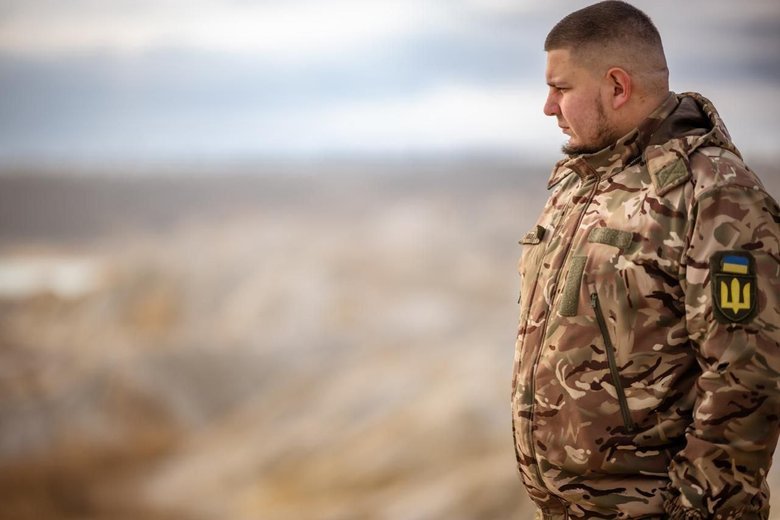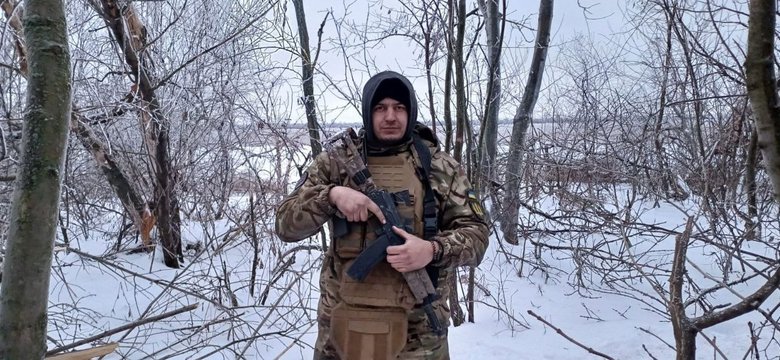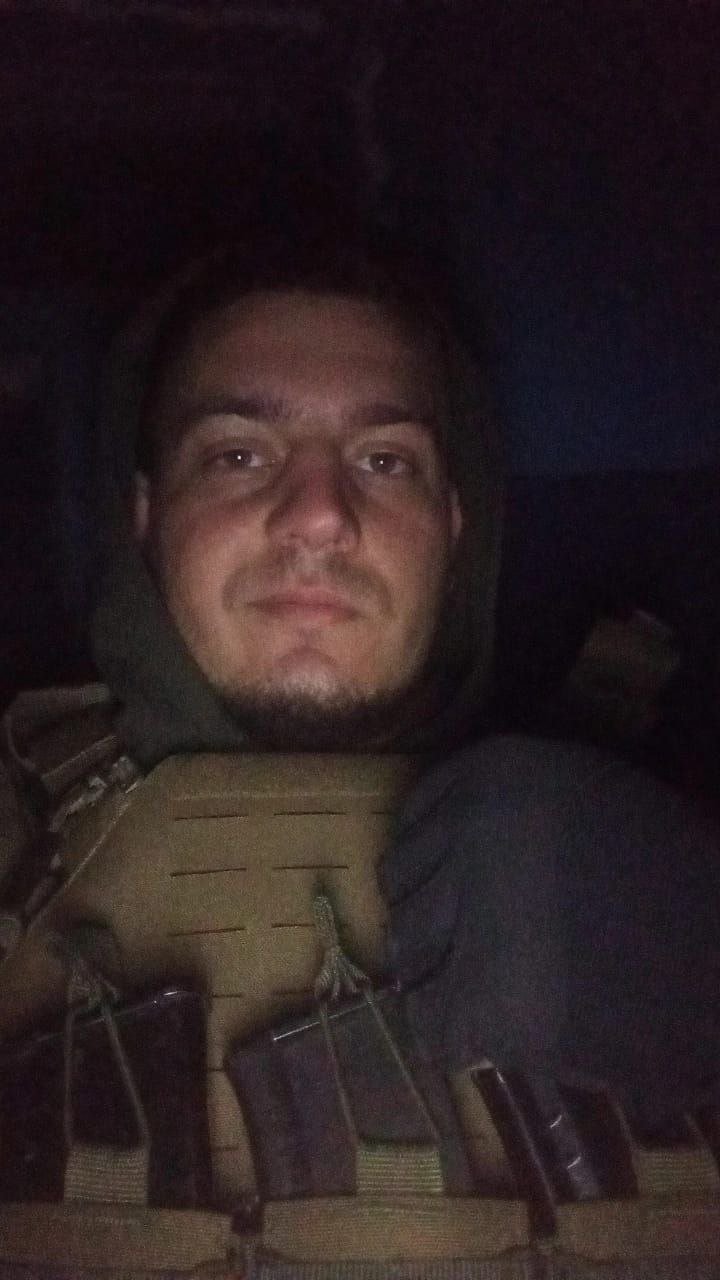We are constantly making progress, our technical unit assembles unique bombers that cannot be bought anywhere – Viacheslav Feoktistov, commander of strike UAV platoon of 23rd SMB
Viacheslav Feoktistov (Skif) has led the strike UAV platoon of the 23rd Separate Mechanized Brigade (SMB) for a year. A native of Oleksandriia in the Kirovohrad region, he has served in the Armed Forces for two years and seven months. He speaks little and modestly about his exploits, clearly brightening when we begin to discuss his mission as a platoon leader.
Skif has been awarded the Iron Cross, while several soldiers in his platoon hold Gold Crosses. He spoke to Censor.NET about the daily life of a UAV operator, the skill of maintaining his unit’s morale, and the readiness to go all the way.
MY FIRST SUCCESSFUL MUNITION DROP WAS AGAINST ENEMY MANPOWER
- Back in 2023, the situation was rather ambiguous: it was already clear that demobilization would not come anytime soon, while on the other hand, a contract meant a strict obligation. What prompted you at that time to enlist under contract?
- I wanted to sign a contract in the very first days of the Russian invasion, but the enlistment office told me to wait for my turn. The inactivity weighed heavily on me; for half a year, I searched for a way to join the service. The 23rd Brigade was just being formed, so I immediately applied, completed the Basic Combined Arms Training in Desna, and by June 2023, I took part in my first sorties — in Pryiutne, Rymivka, and Liubymivka.
- Let me ask about your call sign, Skif. Your avatar in messengers is a Scythian warrior, and you yourself are from a steppe region. I assume this nickname didn’t just "stick" to you by accident?
- I have always read a lot of history books, and it bothered me that Scythians once lived on our land but almost nothing about them is written in school textbooks. I began collecting accounts from Greek historians and found inspiration in them. In the Kirovohrad region, there are many burial mounds, so that’s how I chose my call sign.
- Did you immediately hold the position of UAV operator?
- Yes, right away. Within five days, I was trained in the "craft" and then sent straight to the positions. At first, we conducted reconnaissance with Mavics and Matrices. Later, we were deployed to Robotyne, where we began working with FPV drones. I was the first in the brigade to carry out successful munition drops.
- Is it officially recorded that you were the first? How did it happen?
- Our brigade was storming katsaps positions, and I felt helpless: I could see what was happening but couldn’t do anything about it. Once, on their positions, we found a stockpile of munitions. I came across F-1 grenades and began dropping them. It worked out well, and later, during assaults, I was ordered to cover our infantry with munition drops. So I bombarded them with their own grenades. After five or six munition drops, no one came out of there anymore. So my first successful munition drop was against enemy manpower. There was great joy in knowing that at least this way, I could help reduce the threats to our guys.
- Which drones do you most enjoy working with?
- At present, we work mainly with FPV bombers. They have a higher payload capacity. Moreover, electronic warfare affects them less. Kamikaze drones have their own appeal, their flight range. In very good weather conditions and with a clear horizon, they can fly up to 30 km.
Against columns of vehicles, especially motorcycles, FPVs are the only choice. For ammo depots, enemy manpower, or dugouts, bombers are better.
- What is the decision-making algorithm for which drone to use in a given case?
- We always have a variety of drones at our positions, so there’s no shortage. The corresponding crews are also present, and they coordinate with each other. For example, if a column is moving, an order immediately comes to use FPVs to disable the head and tail vehicles so the column can’t move. At the same time, bombers fly in to finish off the infantry. And if personnel start pouring out of the vehicles, they are eliminated with munitions drops.
We are constantly in contact with dispatchers. A crew under stress can’t always think rationally, so on the other end of the line, a cool head will always guide them. In addition, there’s what we call a "cloud," which everyone is connected to. Everyone can hear, and if needed, coordinate.
- What methods do you use to counter enemy electronic warfare?
- The Katsap brigades operate on different frequencies, so we switch them as well whenever possible, particularly on bombers and kamikaze drones. That way, at our positions, there can be ten drones operating on different frequencies.
ONCE, I TOOK A RUSSIAN PRISONER WITH A DRONE. LATER, A LOT OF VALUABLE INFORMATION WAS FOUND IN HIS PHONE
- Have you had experience in duels with Russian drones?
- Of course, especially with FPVs, including those on fiber optics, as well as with wings. They are assembled from the cheapest components and don’t always reach their target. But there are very, very many of them. If we deploy two crews, they deploy seven.
They also now use a tactic of not hovering but waiting: they land the drone in standby mode, and the moment it’s needed, it immediately takes off.
- This change in enemy UAV tactics has been mentioned for several months. What about their infantry tactics, do you have a formed impression of that?
- When a drone is in standby mode, our radars don’t detect it. Once it lands, it disappears from the radar, and many think it has detonated, but in reality, it’s just waiting. It can sit there for 20–30 minutes, right in the areas where our logistics routes pass.
As for infantry, they now send 2–3 men for an assault. If we eliminate them, within half an hour or an hour, another group comes, and this is how they press with mass. Sometimes, if there are 5–6 tree lines running parallel, they can simultaneously send several such groups there, which we can’t hold back. On 3–4 lines, we can quickly kill the enemy, but if they are densely packed, then on the last ones, they manage to break through.
- Have you had any direct contact with the enemy, close combat or taking prisoners?
- Especially in Avdiivka. They came within 200–300 meters of us, so we had to engage: one would attach a munition while another got ready to meet them.
Once, I captured a Russian with a drone, also in the Avdiivka sector. A group of them was moving, and I flew out with a VOG-17. I inflicted KIA and WIA on most of them, but one, wounded in the left leg, seemed determined to survive. He threw away all his belongings, raised his hands, and began waving his jacket. I steered the drone to the left, signaling him to head toward our infantry. I escorted him with the drone until our guys intercepted him.
He later went for an exchange, but before that, a lot of valuable information was found in his phone. He had been fighting since the very first days of the invasion.
- Drone crews are a primary target for the enemy. There’s an illusion that UAV operator work is relatively safe, especially compared to infantry. How true is that in your experience?
- Whether it’s FPVs, large wings, or reconnaissance drones — everything flies at us. Near Ocheretyne, we once endured such massive shelling: the morning began with mortars, and ended with KABs mixed with tank and GRAD fire. That’s when I sustained my third concussion. We stayed in the shelter until evening, and then at night, the entire crew, all concussed, ran for evacuation. In two weeks, we had to change four positions because they were simply blown apart.
A drop crew consists of 3–4 people: two pilots and the loaders. The loader’s task is to mount the munition, arm it, and if the release system fails, the drone returns to the launch point and the loader disarms it. So the danger is tied not only to enemy fire but also directly to configuring the drone.
- Which combat episode stands out to you the most?
- This winter, four armored boxes advanced, and no one could approach them, so we had to work from 200 meters to hinder their movement. Our pilot struck an IFV on the sixth or seventh attempt. At first, the Russians kept moving forward, but then they turned around and pulled back. It was truly an adrenaline-filled mission.
- Were you awarded the Iron Cross for a specific mission or for your overall work?
- For my work in the Avdiivka sector. That was the hottest area during my entire service.
SINCE I TOOK COMMAND OF THE PLATOON, ITS EFFECTIVENESS HAS INCREASED BY 100%
- What motivated you to become a platoon leader? Was it your desire?
- After serving in Robotyne and Uytne in Avdiivka, I led two groups operating Mavics. Back then, just four of us repelled seven infantry assaults (in one attack, more than 50 enemy troops advanced), sitting 1.2 km away from their positions across a field.
After that, during rotation, the artillery chief called me and said I would head the reconnaissance unit of the 2nd self-propelled artillery battalion. I refused, but the order was already in place. I served in that position for about half a year. About a year ago, a vacancy opened in the UAV battalion as my former commander was transferring to another brigade. A friend of mine, who had become a company commander, invited me, and that’s how I took command of the munition-drop platoon.
Now I am a junior sergeant, but I have long been serving in an officer’s position. I don’t want to go to officer training courses because that would mean dropping out for half a year.
- Why did you refuse to be head of reconnaissance? After all, UAVs are an important component of it.
- Reconnaissance is more tied to artillery, while I always wanted to be a combat officer, not sit in headquarters.
- What goal do you set for yourself in your work as a platoon commander? It’s a small unit, but in extreme and combat conditions even the mood of one person can play a decisive role.
- When I took the position, I realized that my predecessor had been careless. For me, the lives of the pilots come first. That largely depends on the safety of the position chosen, the access routes, and logistics. The second goal is to become one of the best in the brigade. We are constantly making progress, we have our own technical department that assembles unique bombers that cannot be bought anywhere. We create them, test them on our own ranges, and our engineers produce various types of munitions. Since I took command, the platoon’s effectiveness has increased by 100%.
- So, in a way, you’ve got a whole co-operative craft society going there?
- Yes, we have a platoon of pilots, a technical department of analysts, and an engineering section that manufactures munitions.
- How do you measure effectiveness? Is it about scaling up or improving accuracy?
- First of all, range. When I took command of the platoon, our drones could fly a maximum of 5–6 kilometers and carry munitions of up to one kilogram. Now we can fly 12 kilometers and carry three kilograms. So our pilots now sit in cover at a distance comparable to mortar crews.
- Does your technical department analyze performance?
- Yes, we’ve even created special tables where we record data for every sortie: time of flight, type of munition drop, degree of target damage, emergency munition drop, loss of the drone… A video is attached to each sortie. We conduct analyses daily.
- Do you communicate with other UAV units, both within your brigade and beyond? Do you exchange experience?
- When we enter a new sector, we coordinate with neighboring brigades. There’s always an exchange of experience. We worked especially closely with the Haidamaky unit, and now with the 80th Air Assault Brigade. I’ve given many people advice on producing munitions, how to make them more powerful, to increase both blast effect and fragmentation.
- How do you overcome fear? Your mood and behavior largely shape the atmosphere among your subordinates, but for you that means added responsibility.
- When I headed out to the positions, I left all emotions back at the staging point I was departing from. In stalemate situations, I suppressed panic in myself and in my comrades. Because most mistakes are made in panic, and those mistakes are fatal. It happens chaotically and almost automatically inside me. I know the law of the crowd: if everyone goes left, you’ll go left too. So I did everything to prevent panic: phones, having a smoke, counting fingers, or just sitting silently. Fear is always there, but no one ever showed it.
- Obviously, you and your comrades discuss the current mobilization, the atmosphere in the rear. Across the front, it’s no secret that there’s a shortage of soldiers, which is why there’s no demobilization, rotations are limited, and it can be difficult to get leave. How do you personally see your future in the military, given all this?
- I’ll stay until the end, because if we give them a pause, they’ll build up even more strength and we’ll return to where we started. I don’t even want to use the word "resigned myself," I simply understand it. When I joined the army, despite the so-called ceasefire, the Russians kept shelling us constantly, so I don’t trust them at all.
Olha Skorokhod, Censor.NET




